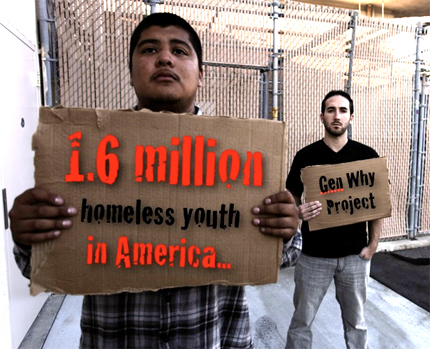Unsheltered Youth
SDSU alumnus Adam Steel shines a light on Americas 1.6 million homeless youth.

Adam Steel and Eric Saldivar share an improbable friendship.
Steel was raised in a stable, upper-middle class Orange County home, attended award-winning schools, earned a communication degree from SDSU and landed a job as a producer and public relations director for a philanthropic multimedia company.
Saldivar spent his formative years in a mostly single-parent apartment on the opposite side of the county. Saldivar’s mother kicked him out of the apartment at age 11 because he reminded her of his imprisoned father. And after barely completing his freshman year of high school, Saldivar dropped out for good.
Getting to know one another
Saldivar found shelter with his best friend’s family, but problems persisted there too, and at age 13 he found himself living on streets of Southern California, becoming one of the 1.6 million homeless youth in America.
At 18, Saldivar was arrested and spent nine months in prison for his role in a high-speed police chase involving a stolen car.
After serving his sentence, Saldivar sought assistance from StandUp For Kids, a non-profit organization aimed at helping homeless youth. Shortly after, the organization asked him to participate in a documentary about Orange County’s homeless youth, which was being produced by Change For Balance Productions, the multimedia company that hired Steel.
“The motto for us is ‘opportunity for all’ — if you provide youth with an opportunity that wasn't there before, true transformation can begin.”
That’s when the SDSU alumnus met Saldivar.
“I could tell that if he had a little more encouragement and support — someone to kind of get his back and help him when he needed it and get his confidence up — that would kind of push him in a positive direction to create the life he wanted,” Steel said.
Steel and Saldivar began meeting weekly through StandUp For Kids, but Steel saw something in Saldivar and took it upon himself to help the troubled teen get his life back on track. Steel bought him clothes and treated him to lunch several times. He also helped Saldivar with résumé writing and interview techniques.
“For most of my life on the streets, I never really met people who actually wanted to help me,” Saldivar said. “At first I felt weird about the whole situation, but then I realized that Adam is a good guy.
“He’s like a mentor — someone I look up to.”
‘Generation Why?’ comes to life
StandUp For Kids was unable to fund the documentary, but Steel was set on finding a home for the production.
Cue Rich German, a renowned life coach, and Christine Brooke, the outreach chairperson for Foster Care Alumni of America, who were introduced to Steel through a mutual friend. Last June, the three parties agreed to produce a documentary to explore the landscape of America’s homeless youth, called “Generation Why?”
“The goal is to inform, educate and inspire people to action,” Steel said.
“Generation Why?” will follow German through five major U.S. cities with dense homeless youth populations.
“We’re going to focus on homeless kids in each city, learn their stories, find out how they ended up on the streets and what they’re doing to get off the streets — if anything — who’s helping them and what their plans are for the future,” Steel said.

The documentary also will address common stereotypes associated with homelessness and identify the real issues surrounding these stigmas.
“The fact is you’re a product of your environment — and most of these kids come from horrible environments and bad family life,” he added. “And that reflects them moving to the streets, whether it be because it is safer on the streets, or because they’re abused physically, sexually or mentally in the home.”
Additionally, “Generation Why?” will include:
- A collection of interviews with celebrities, foster youth and teens, homeless survivors and those who currently serve the homeless youth community
- Survival methods, success stories and support systems
- Proposed changes, specifically to the foster care system
The documentary is still in pre-production — Steel said they have raised about 20 percent of the $180,000 budget — and although the documentary is somewhat time-sensitive, Steel and his associates do not want to compromise the impact of “Generation Why?” by rushing its production.
“Our mentality is you have one opportunity to make the film and to make it right, so we want to maintain the professionalism and integrity of it,” he said. “The better it is, the more effect it will have.”
Taking action now
In the meantime, Change For Balance Productions and the Gen Why Project are making a Web-based mini-series — “The CUT” — to set the stage for “Generation Why?”
In collaboration with The CUT Studios, a non-profit organization that career opportunities in music for at-risk and foster youth, the series will highlight positive transformations for youth facing difficult circumstances.
“The motto for us is ‘opportunity for all’ — if you provide youth with an opportunity that wasn't there before, true transformation can begin,” Steel said. “It starts with an opportunity, and it can grow into so much more.”
“The motto for us is ‘opportunity for all’ — if you provide youth with an opportunity that wasn't there before, true transformation can begin.”
The series, which is set to air on the Gen Why Youtube channel in early 2012, also aims to break the common Orange County stereotypes created by reality television shows such as “The OC” and “Laguna Beach,” which characterize the county’s residents as having a “perfect life,” Steel said.
“The stats show that 22,000 youth are experiencing some sort of homelessness in grades K-12 in Orange County, so it’s definitely been swept under the rug, as it has been all over the country.”
The Gen Why Project
“Generation Why?” and “The CUT” are part of an all-encompassing campaign — a non-profit called the Gen Why Project — to raise awareness about the roughly 1.6 million homeless youth in America.
“You can’t attempt to change a problem unless you know what’s going on,” said Steel, executive director of the Gen Why Project.
Through the non-profit, Steel plans to develop strategic alliances with various organizations, including universities, where he wants to create on-campus Gen Why clubs across the country.

“The goal is to help Eric and many more like Eric get the help they need,” Steel said. “I don’t think there’s anything more powerful than youth helping youth.”
This past spring semester, Steel helped SDSU communication junior Lauren Sullivan and other students create an on-campus Gen Why Club, which is scheduled to launch this fall.
“College kids don’t know that there’s people our age and younger out there who could definitely benefit from even just talking to some of us,” said Sullivan, who will be the club’s vice president. “If I can just raise people’s awareness about homeless youth, that would be great.”
Samira Rostami, an SDSU graduate student, believes the project will help change the public’s perception about homeless people in general.
“Most people have never had a conversation with a homeless person,” said Rostami, who will serve as the club’s public relations officer. “They erroneously perceive homeless individuals to be delinquent, needy and socially incompetent.
“Gen Why can fill that gap by providing people access and information about both individual homelessness and the greater concept of homelessness.”
To inquire about SDSU’s Gen Why Club, email Sullivan at [email protected]. For more information about the “Generation Why?” documentary, “The CUT” or the Gen Why Project, visit www.GenWhyMovie.com.



